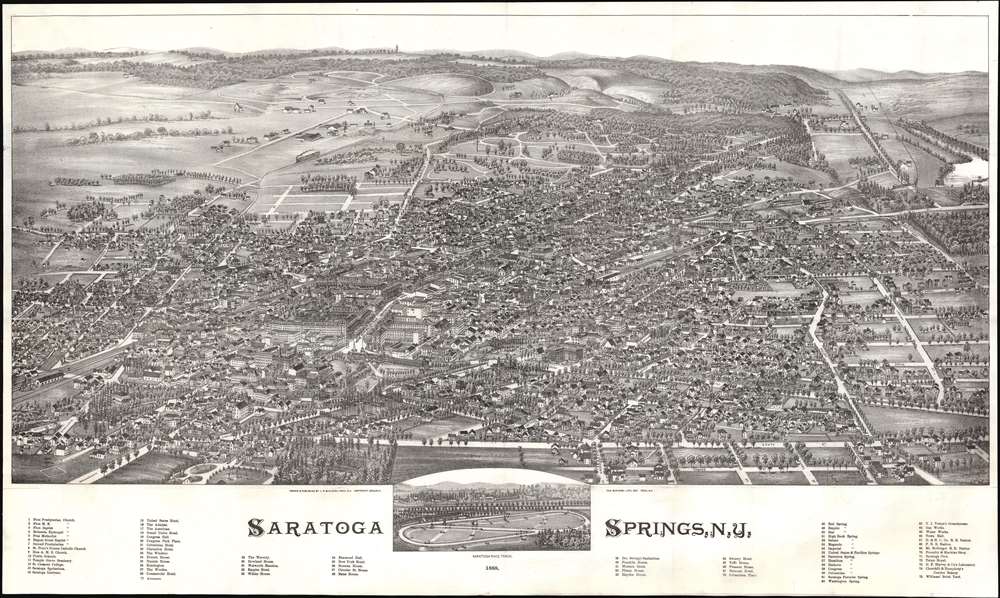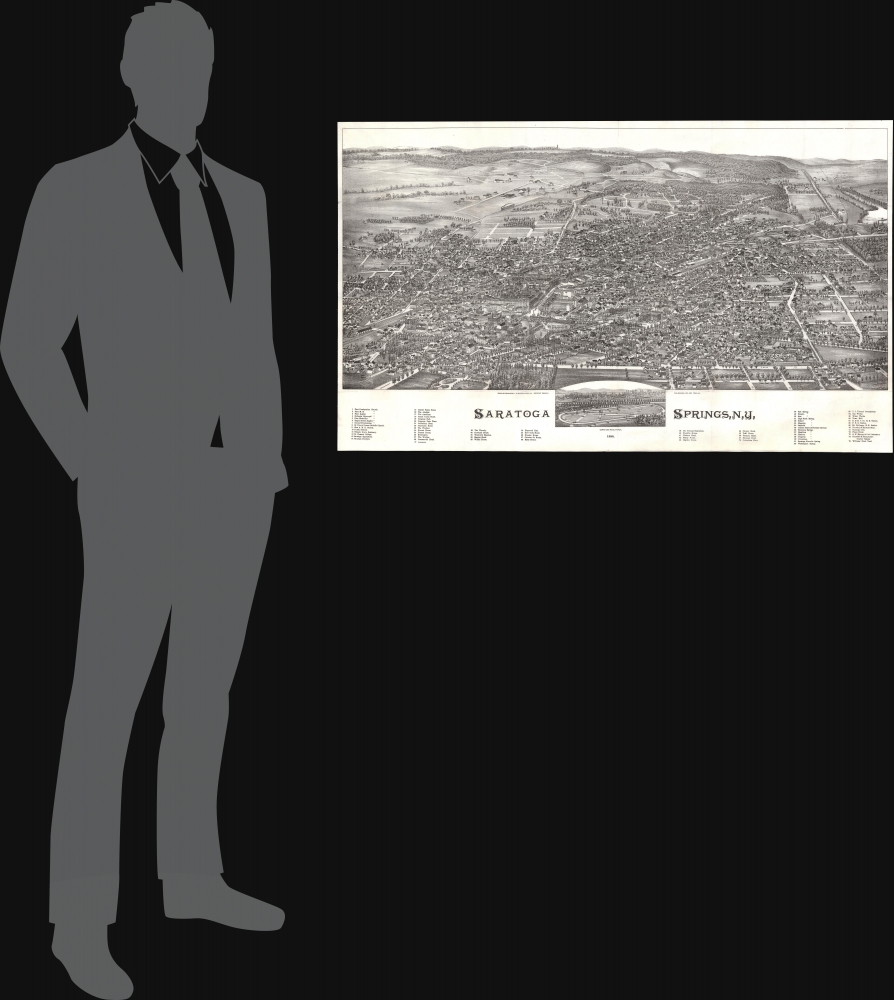1888 Burleigh Bird's-Eye View of Saratoga Springs, New York
SaratogaSprings-burleigh-1888
Title
1888 (dated) 20.25 x 34 in (51.435 x 86.36 cm)
Description
A Closer Look
The view looks northward on Saratoga Springs from a high point just south of town. Although the famous racetrack, built in 1863, is beyond the scope of the view, it is featured via inset at bottom center. Some 75 locations are numerically keyed at the bottom of the map, with entries 48 - 62 identifying 14 of the city's namesake mineral springs. The view further emphasizes Saratoga Springs' ample access to railroad networks, providing easy access from New York, Boston, and Albany, as well as a plethora of grand hotels for the spa-going elite. The Saratoga Sanitarium, once a refuge for tuberculous patients, now a creepy abandoned building, the subject of any number of 'ghost hunts', is identified.Saratoga Springs
Saratoga Springs was established in 1819 from the western portion of Saratoga, becoming an incorporated village in 1826. In 1832, the Saratoga and Schenectady Railroad reached Saratoga Springs, giving it easy access to Albany and, later, New York. With the rise of the American tuberculosis epidemic in the 19th century, doctors began calling for European-style sanitariums. Saratoga Springs, with its clean Adirondack air, healing mineral springs, and easy access to major cities, was developed as a spa and healing center. Resort hotels, spas, and other facilities developed to accommodate an inrush of tourists and patients suffering from the 'white plague'. Grand Hotels included the United States, and the Grand Union, in its day the world's largest hotel. In 1863, the Saratoga Racecourse opened. Horse racing capitalized on the existing tourism infrastructure and added gambling to the city's attractions. In 1870, the Delaware and Hudson Canal Company began running the Empire State Express, creating a direct connection between New York City and the increasingly popular resort town. Today, although the sanitarium has long fallen into ruin, the city remains a center for horse racing, spa activities, and the arts.American Bird's-Eye City Views
The tradition of the bird's-eye city view emerged in the United States in the middle part of the 19th century and coincided with the commercial development of lithographic printing. Before the rise of lithography, the ability to own and display artwork in the home was limited to the wealthy. The advent of lithographic printing made it possible for everyone to own visually striking artwork. A robust trade developed in portraits of political leaders, allegorical and religious images, and city views.City views were being produced in the United States as early as the 1830s, but the genre exploded after the American Civil War (1861 - 1865). Bridging the gap between maps and pictures, most 19th-century American bird's-eye views presented cities to the public from high vantage points. Some were imagined, but others were drawn from hot-air balloons or nearby hills. The presentation, combining high elevation, commercial interest, and new printing technology, created a uniquely American art form, as described by historian Donald Karshan,
Some print connoisseurs believe that it was only with the advent of the full-blown city-view lithograph that American printmaking reached its first plateau of originality, making a historical contribution to the graphic arts. They cite the differences between the European city-view prints and the expansive American version that reflects a new land and a new attitude toward the land.The vogue for bird's-eye city views lasted from about 1845 to 1920, during which period some 2,400 cities were thus portrayed, some multiple times. Although views were produced in many urban centers, the nexus of view production in the United States was Milwaukee, Wisconsin. The major American viewmakers were Stoner, Wellge, Bailey, Fowler, Hill, Ruger, Koch, Burleigh, Norris, and Morse, among others.
Publication History and Census
This view was published by Lucien R. Burleigh in Troy, New York. The view was simultaneously issued in at least two states. The present 1-plate state, and a 2-plate chromolithograph variant. The present view is likely the earlier of the two, issued while the second plate, used to introduce clouds, was in progress. We have identified no other examples of this 1-plate edition, but 2-plate examples are noted in the Library of Congress, the Clements Library at the University of Michigan, the New York State Library, and at the Saratoga Springs Public Library. Scarce to the market.Cartographer
Lucian Rinaldo Burleigh (February 6, 1853 – July 30, 1923) was an American lithographer and view maker active in the latter part of the 19th century. Burleigh was born in Plainfield, Connecticut and studied civil engineering at Worcester County Free Institute of Industrial Science (Worcester Polytechnic). There he studied under George E. Gladwin who specialized in field sketching. Burleigh became one of Gladwin's prized students and this no doubt influenced his choice to become a viewmaker. Burleigh's view work stands out for two reasons. One, most of his town views are drawn form a lower than usual point of view enabling him to take greater advantage of profile perspectives. Two, his views do not integrate people or animals – most late 19th century American view artists added horses, people, carts, dogs, and even chickens to their views. Between the years of 1883 and 1885 Burleigh produced some 28 views of New York towns and cities. Most of these were published by either Beck and Pauli of Milwaukee or C. H. Voght of Cleveland. After 1886, Burleigh established his own Troy press and subsequent views were published in-house. Burleigh also worked as a lithographer for other view makers including J. J. Stoner and Albert Ruger, among many others. Burleigh contributed to the production of about 228 lithographic city views and personally drew about 120, marking him one of the most important and influential viewmakers of the 19th century. More by this mapmaker...




